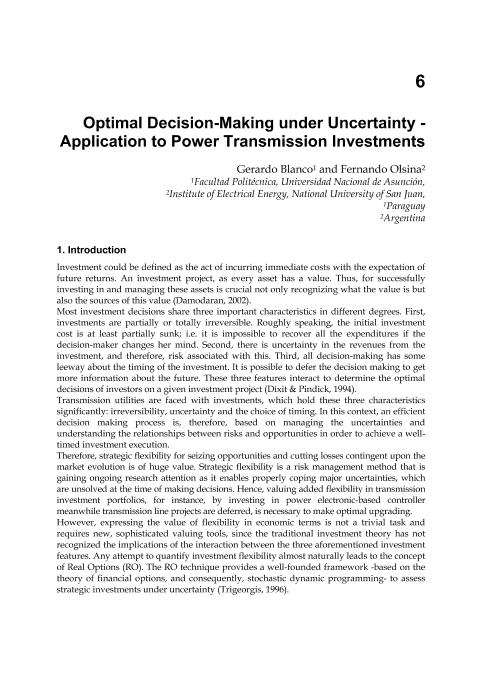Mostrar el registro sencillo del ítem
dc.contributor.author
Blanco, Gerardo
dc.contributor.author
Olsina, Fernando Gabriel

dc.contributor.other
Dritsas, Ioaniss
dc.date.available
2022-06-09T13:21:37Z
dc.date.issued
2011
dc.identifier.citation
Blanco, Gerardo; Olsina, Fernando Gabriel; Optimal decision. Making under uncertainty: Application to power transmission investments; IntechOpen; 2011; 107-140
dc.identifier.isbn
978-953-307-829-8
dc.identifier.uri
http://hdl.handle.net/11336/159342
dc.description.abstract
Economists define investment as the act of incurring immediate costs with the expectation of future returns. An investment project, as every asset has a value. For successfully investing in and managing these assets is crucial not only recognizing what the value is but also the sources of this value. Most investment decisions share three characteristics in different degrees. First, investments are partially or totally irreversible. Roughly speaking, the initial investment cost is at least partially sunk; i.e. it is impossible to recover all the expenditures if the decision-maker changes his mind. Second, there is uncertainty in the revenues from the investment, and therefore, risk associated with this. Third, all decision-making has some leeway about the timing of the investment. It is possible to defer the decision making to get more information about the future. These three features interact to determine the optimal decisions of investors on a given investment project. Transmission utilities are faced with investment projects, which hold these three characteristics: irreversibility, uncertainty and the choice of timing. In this context, an efficient decision making process is, therefore, based on managing the uncertainties and understanding the relationships between risks and opportunities in order to achieve a well-timed investment execution. Therefore, strategic flexibility for seizing opportunities and cutting losses contingent upon the market evolution is of huge value. Strategic flexibility is a risk management method that is gaining ongoing research attention as it enables properly managing major uncertainties, which are unsolved at the time of making decisions. Hence, valuing added flexibility in transmission investment portfolios, for instance, by investing in power electronic-based controller meanwhile transmission line projects are deferred, is necessary to make optimal network upgrading. Nevertheless, expressing the value of flexibility in economic terms is not a trivial task and requires new, sophisticated valuing tools, since the traditional investment theory has not recognized the important implications of the interaction between the three aforementioned investment features. Any attempt to quantify investment flexibility almost naturally leads to the concept of Real Options (RO). The RO technique provides a well-founded framework –based on the theory of financial options, and consequently, stochastic dynamic programming- to assess strategic investments under uncertainty. In the first RO applications, valuation was normally confined to the investment options that can be easily assimilated to financial options, for which solutions are well-known and readily available. Nevertheless, an investor confront with a diverse set of opportunities. From this point of view, investment projects can be seen as a portfolio of options, where its value is driven by several stochastic variables. The introduction of multiple interacting options into real options models highly increases the problem complexity, making traditional numerical approaches impracticable. However in the recent years, simulation procedures for solving multiple American options have been successfully proposed. One of the most promising approaches is the Least Square Monte Carlo (LSM) method proposed by Longstaff and Schwartz in 2001. LSM method is based on stochastic chronological simulation and uses least squares linear regression to determine the optimal stopping time (optimal path) in the decision making process. This chapter lays out a general background about key concepts -uncertainty and risk- and the most usual risk management techniques in transmission investment are provided. Then, the concept of strategic flexibility is introduced in order to set its ability for dealing with the uncertainties involved in the investment problem. In addition, new criteria and advantages of ROV approach compared with classical probabilistic choice are presented, by exposing a LSM-based method for decomposing and evaluating the complex real option problem involved in flexible transmission investments under uncertainties. The proposed methodology is applied in a study case which evaluates an interconnection reinforcement on the European interconnected power system, by showing how the valuation of flexibility is a key task for making efficient and well-timed investments in the transmission network. The impact of two network upgrades on the system-wide welfare is analyzed. These upgrades are the development of a new interconnected line and the installation of a power electronic-based controller. Both upgrades represent measures to strengthen the German-Dutch interconnections due to the fact that these are among the most important corridors within the Central Western European (CWE) region. Hence, an interconnection project, which is currently under study, is compared to flexible investment in order to shed some light on the influence of the strategic flexibility on the optimal decision-making process. The research is focused on assessing the impact of different wind power in-feed scenarios in detail as well as the uncertainty of the demand growth, generation cost evolution and the installed wind capacity on the decision-making process. The presented approach might serve as a basis for a decision-making tool for regulatory agencies in order to quantify the necessity for network upgrades.
dc.format
application/pdf
dc.language.iso
eng
dc.publisher
IntechOpen

dc.rights
info:eu-repo/semantics/openAccess
dc.rights.uri
https://creativecommons.org/licenses/by-nc-sa/2.5/ar/
dc.subject
REAL OPTIONS
dc.subject
INVESTMENT VALUATION
dc.subject
STOCHASTIC SIMULATION
dc.subject
DYNAMIC PROGRAMMING
dc.subject.classification
Ingeniería Eléctrica y Electrónica

dc.subject.classification
Ingeniería Eléctrica, Ingeniería Electrónica e Ingeniería de la Información

dc.subject.classification
INGENIERÍAS Y TECNOLOGÍAS

dc.title
Optimal decision. Making under uncertainty: Application to power transmission investments
dc.type
info:eu-repo/semantics/publishedVersion
dc.type
info:eu-repo/semantics/bookPart
dc.type
info:ar-repo/semantics/parte de libro
dc.date.updated
2022-06-06T16:05:49Z
dc.journal.pagination
107-140
dc.journal.pais
Reino Unido

dc.journal.ciudad
Londres
dc.description.fil
Fil: Blanco, Gerardo. Universidad Nacional de Asunción; Paraguay
dc.description.fil
Fil: Olsina, Fernando Gabriel. Consejo Nacional de Investigaciones Científicas y Técnicas. Centro Científico Tecnológico Conicet - San Juan; Argentina. Universidad Nacional de San Juan. Facultad de Ingeniería. Instituto de Energía Eléctrica; Argentina
dc.relation.alternativeid
info:eu-repo/semantics/altIdentifier/url/https://www.intechopen.com/chapters/13870
dc.relation.alternativeid
info:eu-repo/semantics/altIdentifier/doi/http://dx.doi.org/10.5772/15625
dc.conicet.paginas
490
dc.source.titulo
Stochastic optimization: seeing the optimal for the uncertain
Archivos asociados
